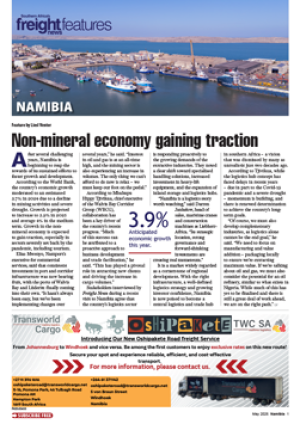When asked what his
view was of one
of the significant
changes likely to
happen in the future (the next 40
years or so), Matt Conroy, Maersk
Line’s trade and marketing
manager, proved himself a
supporter of renewable fuels.
“One of the areas in which
we have not yet fully realised
the benefit of the research and
development invested is the use of
renewable energy,” he said.
“This is definitely an area
where we foresee significant gains
over the next four decades within
the shipping industry. This will
reduce the dependence on the
conventional bunker fuel and as a
result Co2 emissions.”
As he said, these renewable fuel
types are lower emission power
sources which will help shipping
lines comply with the emission
control legislation in the pipeline.
From estimates available to
Conroy from the US Energy
Information Administration
(EIA), there are worrying
statistics for any industry that is
heavily dependent on fossil fuels.
The burning of fossil fuels
produces around 21.3 billion
tonnes (21.3 gigatonnes) of
carbon dioxide (CO2) per year,
but it is estimated that natural
processes can only absorb about
half of that amount.
So there is a net increase
of 10.65 billion tonnes
of atmospheric
carbon dioxide per
year (one tonne of
atmospheric carbon
is equivalent to
44/12 or 3.7 tonnes
of carbon dioxide).
Carbon dioxide is
one of the greenhouse
gases that enhances
radiative forcing
– defined as the
difference between
radiant energy
received by the earth
and energy radiated
back to space – and
contributes to global
warming, causing the
average surface temperature of
the earth to rise in response.
This, the vast majority of climate
scientists agree, will cause major
adverse effects.
But renewable fuels are more
forward looking than just being
lower emission power sources.
They will also be a vital answer
to the not-so-distant time when
the global reserve of fossil
fuels runs dry.
If information published by
the on-line encyclopaedia,
Wikipedia, is to be
believed, it is not
likely to occur in
the lifespan
of most
of
FTW’s readers. But, it is certainly
due to happen in the lifetimes of
their children.
The estimate for the years of
production left in the ground
with the current proved reserves
and outflow is:
Coal: 148 years
Oil: 43 years
Natural gas: 61 years
And the years of production
left in the ground (with the
most optimistic proved reserve
estimates) published by the Oil &
Gas Journal on World Oil is:
Coal: 417 years
Oil: 43 years
Natural gas: 167 years
Remember, fossil fuels are nonrenewable
resources because they
take millions of years to form, and
reserves are being depleted much
faster than new ones are being
made. The production and use of
fossil fuels raise environmental
concerns.
Therefore, as Conroy said, a
global movement toward the
generation of renewable energy is
under way to help meet increased
energy needs.
Renewable fuels will change the landscape
09 Sep 2013 - by Alan Peat
0 Comments
40 Years 2013

09 Sep 2013
09 Sep 2013
09 Sep 2013
09 Sep 2013
09 Sep 2013
09 Sep 2013
09 Sep 2013
09 Sep 2013
09 Sep 2013
09 Sep 2013
09 Sep 2013
09 Sep 2013
